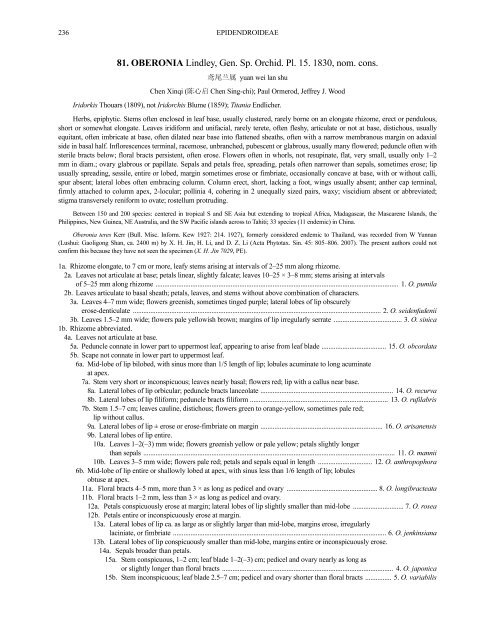Create successful ePaper yourself
Turn your PDF publications into a flip-book with our unique Google optimized e-Paper software.
236<br />
EPIDENDROIDEAE<br />
81. OBERONIA Lindley, Gen. Sp. Orchid. Pl. 15. 1830, nom. cons.<br />
鸢尾兰属 yuan wei lan shu<br />
Chen Xinqi (陈心启 Chen Sing-chi); Paul Ormerod, Jeffrey J. Wood<br />
Iridorkis Thouars (1809), not Iridorchis Blume (1859); Titania Endlicher.<br />
Herbs, epiphytic. Stems often enclosed in leaf base, usually clustered, rarely borne on an elongate rhizome, erect or pendulous,<br />
short or somewhat elongate. Leaves iridiform and unifacial, rarely terete, often fleshy, articulate or not at base, distichous, usually<br />
equitant, often imbricate at base, often dilated near base into flattened sheaths, often with a narrow membranous margin on adaxial<br />
side in basal half. Inflorescences terminal, racemose, unbranched, pubescent or glabrous, usually many flowered; peduncle often with<br />
sterile bracts below; floral bracts persistent, often erose. Flowers often in whorls, not resupinate, flat, very small, usually only 1–2<br />
mm in diam.; ovary glabrous or papillate. Sepals and petals free, spreading, petals often narrower than sepals, sometimes erose; lip<br />
usually spreading, sessile, entire or lobed, margin sometimes erose or fimbriate, occasionally concave at base, with or without calli,<br />
spur absent; lateral lobes often embracing column. Column erect, short, lacking a foot, wings usually absent; anther cap terminal,<br />
firmly attached to column apex, 2-locular; pollinia 4, cohering in 2 unequally sized pairs, waxy; viscidium absent or abbreviated;<br />
stigma transversely reniform to ovate; rostellum protruding.<br />
Between 150 and 200 species: centered in tropical S and SE Asia but extending to tropical Africa, Madagascar, the Mascarene Islands, the<br />
Philippines, New Guinea, NE Australia, and the SW Pacific islands across to Tahiti; 33 species (11 endemic) in China.<br />
Oberonia teres Kerr (Bull. Misc. Inform. Kew 1927: 214. 1927), formerly considered endemic to Thailand, was recorded from W Yunnan<br />
(Lushui: Gaoligong Shan, ca. 2400 m) by X. H. Jin, H. Li, and D. Z. Li (Acta Phytotax. Sin. 45: 805–806. 2007). The present authors could not<br />
confirm this because they have not seen the specimen (X. H. Jin 7029, PE).<br />
1a. Rhizome elongate, to 7 cm or more, leafy stems arising at intervals of 2–<strong>25</strong> mm along rhizome.<br />
2a. Leaves not articulate at base; petals linear, slightly falcate; leaves 10–<strong>25</strong> × 3–8 mm; stems arising at intervals<br />
of 5–<strong>25</strong> mm along rhizome ........................................................................................................................................... 1. O. pumila<br />
2b. Leaves articulate to basal sheath; petals, leaves, and stems without above combination of characters.<br />
3a. Leaves 4–7 mm wide; flowers greenish, sometimes tinged purple; lateral lobes of lip obscurely<br />
erose-denticulate .............................................................................................................................................. 2. O. seidenfadenii<br />
3b. Leaves 1.5–2 mm wide; flowers pale yellowish brown; margins of lip irregularly serrate ....................................... 3. O. sinica<br />
1b. Rhizome abbreviated.<br />
4a. Leaves not articulate at base.<br />
5a. Peduncle connate in lower part to uppermost leaf, appearing to arise from leaf blade ..................................... 15. O. obcordata<br />
5b. Scape not connate in lower part to uppermost leaf.<br />
6a. Mid-lobe of lip bilobed, with sinus more than 1/5 length of lip; lobules acuminate to long acuminate<br />
at apex.<br />
7a. Stem very short or inconspicuous; leaves nearly basal; flowers red; lip with a callus near base.<br />
8a. Lateral lobes of lip orbicular; peduncle bracts lanceolate ............................................................................ 14. O. recurva<br />
8b. Lateral lobes of lip filiform; peduncle bracts filiform ............................................................................... 13. O. rufilabris<br />
7b. Stem 1.5–7 cm; leaves cauline, distichous; flowers green to orange-yellow, sometimes pale red;<br />
lip without callus.<br />
9a. Lateral lobes of lip ± erose or erose-fimbriate on margin ...................................................................... 16. O. arisanensis<br />
9b. Lateral lobes of lip entire.<br />
10a. Leaves 1–2(–3) mm wide; flowers greenish yellow or pale yellow; petals slightly longer<br />
than sepals ................................................................................................................................................ 11. O. mannii<br />
10b. Leaves 3–5 mm wide; flowers pale red; petals and sepals equal in length ............................... 12. O. anthropophora<br />
6b. Mid-lobe of lip entire or shallowly lobed at apex, with sinus less than 1/6 length of lip; lobules<br />
obtuse at apex.<br />
11a. Floral bracts 4–5 mm, more than 3 × as long as pedicel and ovary .................................................... 8. O. longibracteata<br />
11b. Floral bracts 1–2 mm, less than 3 × as long as pedicel and ovary.<br />
12a. Petals conspicuously erose at margin; lateral lobes of lip slightly smaller than mid-lobe ............................. 7. O. rosea<br />
12b. Petals entire or inconspicuously erose at margin.<br />
13a. Lateral lobes of lip ca. as large as or slightly larger than mid-lobe, margins erose, irregularly<br />
laciniate, or fimbriate .......................................................................................................................... 6. O. jenkinsiana<br />
13b. Lateral lobes of lip conspicuously smaller than mid-lobe, margins entire or inconspicuously erose.<br />
14a. Sepals broader than petals.<br />
15a. Stem conspicuous, 1–2 cm; leaf blade 1–2(–3) cm; pedicel and ovary nearly as long as<br />
or slightly longer than floral bracts .................................................................................................. 4. O. japonica<br />
15b. Stem inconspicuous; leaf blade 2.5–7 cm; pedicel and ovary shorter than floral bracts ............... 5. O. variabilis
















